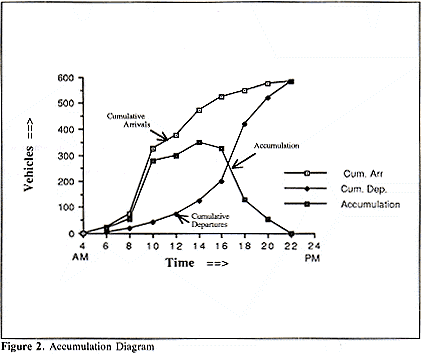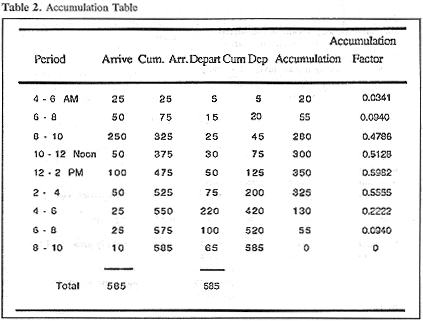
Parking Studies
Studies must be conducted to collect the required information about the capacity and
use of existing parking facilities. In addition, information about the demand for parking
is needed. Parking studies may be restricted to a particular traffic producer or
attractor, such as a store, or they may encompass an entire region, such as a central
business district.
Before parking studies can be initiated, the study area must be defined. A cordon line
is drawn to delineate the study area. It should include traffic generators and a
periphery, including all points within an appropriate walking distance. The survey area
should also include any area that might be impacted by the parking modifications. The
boundary should be drawn to facilitate cordon counts by minimizing the number of entrance
and exit points.
Once the study area has been defined, there are several different types of parking
studies that may be required. These study types are listed below and discussed in detail
in the remaining paragraphs.
- Inventory of Parking Facilities
- Accumulation Counts
- Duration and Turnover Surveys
- User Information Surveys
- Land Use Method of Determining Demand
Inventory of Parking Facilities:
Information is collected on the current condition of parking facilities. This includes:
- the location, condition, type, and number of parking spaces.
- parking rates if appropriate. These are often related to trip generation or other land
use considerations.
- time limits, hours of availability and any other restrictions.
- layout of spaces: geometry and other features such as crosswalks and city services.
- ownership of the off-street facilities.
Accumulation Counts:
These are conducted to obtain data on the number of vehicles parked in a study area during
a specific period of time. First, the number of vehicles already in that area are counted
or estimated. Then the number of vehicles entering and exiting during that specified
period are noted, and added or subtracted from the accumulated number of vehicles.
Accumulation data are normally summarized by time period for the entire study area. The
occupancy can be calculated by taking accumulation/total spaces. Peaking characteristics
can be determined by graphing the accumulation data by time of day. The accumulation graph
usually includes cumulative arrival and cumulative departure graphs as well.


Above Figures taken from:
Khisty, C. and M. Kyte, Lab and Field Manual for Transportation
Engineering, Prentice Hall, Englewood Cliffs, NJ, 1991.
Duration and Turnover Surveys:
The accumulation study does not provide information on parking duration, turnover or
parking violations. This information requires a license plate survey, which is often very
expensive. Instead, modifications are often made to the field data collection protocols.
Note that there is usually a tradeoff between data collection costs and study accuracy.
Spending more time and money may increase accuracy, but at what point does the incremental
change in accuracy become too expensive?
In planning a license plate survey, assume that each patrolling observer can check
about four spaces per minute. The first observer will be slower, because all the license
plate numbers will have to be recorded, but subsequent observers will be able to work much
faster. The form shown below can be used for a license plate survey.
Parking turnover is the rate of use of a facility. It is determined by dividing the
number of available parking spaces into the number of vehicles parked in those spaces in a
stated time period.
Table1. Typical License Plate Survey Field Form for Curbside Survey
Street_______Side ____Study Date_________________
Data Collector_________From_____________________
To ________________ Direction of Travel ___________
| Space No |
Space Desc. |
Time at beginning
of Patrol |
| 8:00 |
8:30 |
9:00 |
9:30 |
10:00 |
10:30 |
11:00 |
11:30 |
| |
|
|
|
|
|
|
|
|
|
| |
|
|
|
|
|
|
|
|
|
| |
|
|
|
|
|
|
|
|
|
| |
|
|
|
|
|
|
|
|
|
| |
|
|
|
|
|
|
|
|
|
| |
|
|
|
|
|
|
|
|
|
| |
|
|
|
|
|
|
|
|
|
User Information Surveys:
Individual users can provide valuable information that is not attainable with license
plate surveys. The two major methods for collecting these data are parking interviews and
postcard studies. For the parking interviews, drivers are interviewed right in the parking
lot. The interviews can gather information about origin and destination, trip purpose, and
trip frequency. The postage paid postcard surveys requests the same information as in the
parking interview. Return rates average about 35%, and may include bias. The bias can take
two forms. Drivers will sometimes overestimate their parking needs in order to encourage
the surveyors to recommend additional parking. Or, they may file false reports that they
feel are more socially acceptable.
Land Use Method of Determining Demand:
Parking generation rates can be used to estimate the demand for parking.
- Tabulate the type and intensity of land uses throughout the study area.
- Based on reported parking generation rates, estimate the number of parking spaces needed
for each unit of land use.
- Determine the demand for parking from questionnaires. A rule of thumb is to overestimate
the demand for parking by about 10 %. If the analysis suggests that the parking demand for
a particular facility will be 500 spaces, then the design should be for 550 spaces.
|